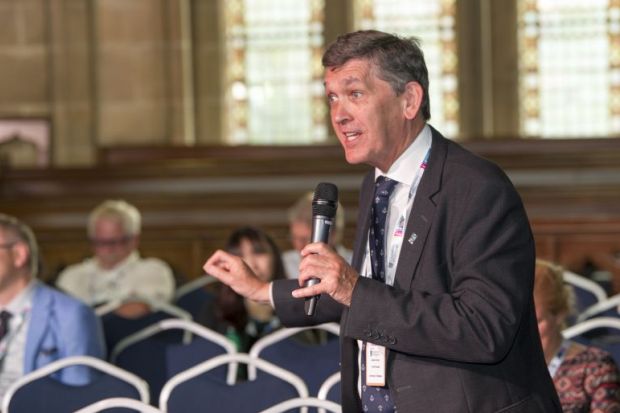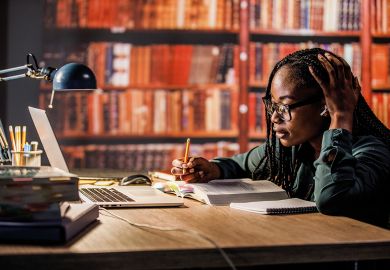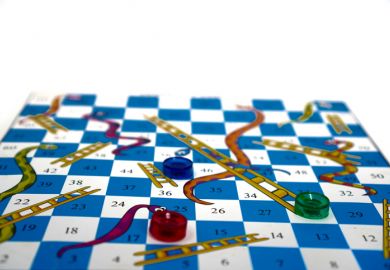Calls to replace the traditional lecture with more interactive teaching miss the value of “slow and difficult learning” and ignore evidence supporting its educational importance, a conference has heard.
In a fiery debate at Times Higher Education’s Teaching Excellence Summit, James Conroy, the University of Glasgow’s vice-principal for internationalisation, hit back at claims that lectures almost always delivered worse student outcomes than “active learning”, in which students typically work in small groups, calling the claims “half-baked nonsense” and “horse manure”.
Contrary to recent claims about the ineffectiveness of lecturing, there is a large body of evidence – including studies by the University of California, Los Angeles educationalists Robert and Elizabeth Bjork – that suggests that long-term “retention and recall is stronger than people imagine” from lectures, said Professor Conroy.
“We have persuaded ourselves that the attention span of students is very short [and] desiccated…so we have created a learning system that meets these low expectations,” Professor Conroy, professor of religious and philosophical education, told delegates at the event, held at Glasgow.
Speaking in a separate session, Professor Conroy said that “the idea that the lecture is a lousy place to learn is a self-fulfilling prophecy”, which led to poor preparation of lectures and badly received talks, adding that universities should “defend slow and difficult learning”.
“This is not to condemn active learning – of course we use many different types of teaching – but it is an appeal for a bit of balance,” he said.
Professor Conroy’s defence came in response to a keynote lecture by Carl Wieman, a Nobel prizewinning physicist from Stanford University who has lately focused on how to improve science teaching. In his address, he stated that “there is no point in lecturing any more” because active learning led to better student learning than lecturing in almost every scenario. Student engagement rates are 40 per cent higher when active learning is used compared with lectures, while dropout rates were more than 50 per cent lower, according to studies contained in his 2017 book Improving How Universities Teach Science.
Asked if good lecturing produced better student outcomes than badly done active learning, Professor Wieman replied that the “research suggests ‘no’”. “In some cases they may be equivalent, but there are no cases I know about where even reasonable active learning does not beat good lecturing,” said Professor Wieman, who added that there is “no evidence where active learning underperforms lecturing”.
Even though some online lectures on YouTube and other platforms received tens of millions of hits, this popularity gave no clue about the learning value of such talks, Professor Wieman told delegates.
“Pornography has lots of hits, celebrity scandals get hits – I give them no credit for hits, so come back and show me how these [measures] correspond to learning,” he said.
Speaking to THE, however, Professor Conroy said that the traditional lecture still worked well when done right because it “requires concentration, analysis and judgement” from students, which were key skills demanded by employers.
The supposed unanimous verdict against lecturing actually reflected “confirmation bias” among researchers who did not acknowledge significant studies showing the efficacy of the lecture, he added.
The desire to abolish lectures was “almost religious” in its fervour and was similarly based mostly on belief rather than evidence, Professor Conroy continued. It was linked to another mistaken belief that graduates required new and different skills from those possessed by previous generations to cope with the so-called Fourth Industrial Revolution, he added.
“Students need tomorrow what they needed yesterday – the capacity to think, reflect, engage and turn things upside down,” said Professor Conroy.
jack.grove@timeshighereducation.com
Watch Carl Wieman's presentation and the following Q&A
POSTSCRIPT:
Print headline: Has the death of the lecture been greatly exaggerated?
Register to continue
Why register?
- Registration is free and only takes a moment
- Once registered, you can read 3 articles a month
- Sign up for our newsletter
Subscribe
Or subscribe for unlimited access to:
- Unlimited access to news, views, insights & reviews
- Digital editions
- Digital access to THE’s university and college rankings analysis
Already registered or a current subscriber? Login










